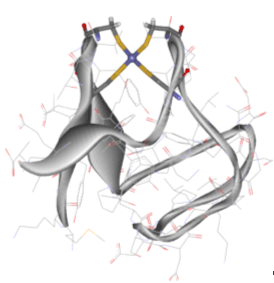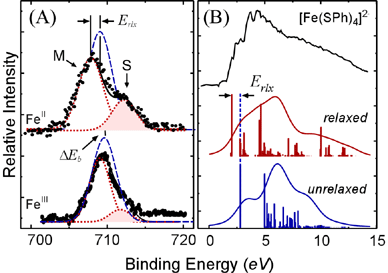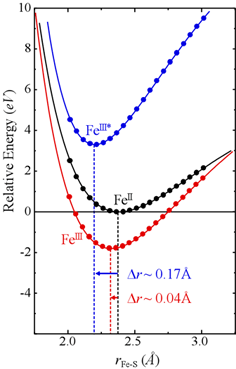
Electron transfer, or the act of moving an electron from one place to another, is amongst the simplest of chemical processes, yet certainly one of the most critical. The process of efficiently and controllably moving electrons around is one of the primary regulation mechanisms in biology. Without stringent control of electrons in living organisms, life could simply not exist. For example, photosynthesis and nitrogen fixation (to name but two of the most well-known biochemical activities) are driven by electron transfer processes. It is unsurprising, therefore, that much effort has been placed on understanding the fundamental principles that control and define the simple act of adding and/or removing electrons from chemical species.
Transition metals such as copper and iron play leading roles in electron transport as one-electron redox-active centers within proteins that are used to effectively move electrons around. Well-known examples are the blue copper proteins (CuI«CuII), cytochromes (FeII«FeIII porphyrins), and iron-sulfur proteins (FeII«FeIII with sulfur ligands). Significant efforts have been placed on developing our understanding of how biological systems control which electron transfer processes are feasible (i.e., reduction potentials) and how fast they will occur (i.e., rate constants).4 The factors that affect the properties of these important biological electron transfer sites are generally considered as either intrinsic (i.e., an inherent behavior and/or property of the site itself) or extrinsic (i.e., modulation of the basic properties by external factors) to the active site. Our recent efforts have served to provide insights into the intrinsic properties of mononuclear iron centers using both experimental and theoretical methods to evaluate their inherent electronic structure and to correlate it to their observed redox properties.1, 2, 3

Using small near-tetrahedral [Fe(SR)4]2-,1- models, we have probed the electronic structure of both the reduced (FeII) and oxidized (FeIII) complexes to obtain insights into their intrinsic redox properties and implications on the properties of Rubredoxins, a class of small electron transport proteins that contain a similar active site (Figure 1).5 An important question was whether electron transfer in these sites was well-described as a one-electron process. Generally, it is assumed that the removal and/or addition of a single electron is a rather simple process and that it does not significantly alter the electronic structure of a transition metal site. Another way of stating this is that we generally assume that electron transfer is a "one-electron" process - our approach to understanding electron transfer processes is rooted in this one-electron approximation. From studies on a related system, it seemed that this assumption might not hold.6, 7
Photoelectron spectroscopy (PES) provided the first evidence that these redox sites might actually be more mysterious than anticipated. In the FeII species, both core and valence PES display intense satellite peaks (see Figure 2), features that result from changes in the electronic structure during the PES experiment, which essentially probes non-adiabatic electron removal. These data therefore provide direct insight into the FeII®FeIII process of interest. From these data, it was shown that there is a large change in the electronic structure of the reduced species upon electron removal and that this electronic relaxation changes the nature of the electron transfer process. Clearly, for [Fe(SR)4]2-,1-, this approximation is simply not valid.1
![Figure 3. Theoretically-derived representation of the loss of an electron on going from [FeII(SCH3)4]2- to [FeIII(SCH3)4]1-. The top figure shows the calculated electron distribution using the one-electron formalism, whereas the bottom figure shows the electron distribution if electronic relaxation is allowed to take place. Figure 3.](/content/sites/default/files/images/science/highlights/2003/etrans-fig3.gif)
This result is well-supported by theoretical results, which allow us to visualize the process and its influence. As we see from Figure 3, the overall electron transfer process looks very different than expected from the simple one-electron model. Using the one-electron model, the electron is removed mostly from the Fe atom, the ligands (the atoms attached to the metal) play only a very small role. However, the true situation is one that involves the ligands very heavily - electronic relaxation distributes the loss of the electron over a much wider volume. It is obvious at this point that relying on the one-electron approach to understand the electron transfer properties of these irons-sulfur sites is insufficient. For this reason, the importance of electronic relaxation on the intrinsic electron transfer properties of these iron-sulfur sites was explored, focusing on both the redox potentials and the rates constants for electron transfer.1
The experimental PES data from Figure 2 have already shown us that electronic relaxation is extremely important for the oxidation process. The major result of this effect is to ensure that electron density is removed more evenly from the site and not simply from the metal itself. This makes the process easier and decreases the energy required to remove an electron, but by how much? It is possible to simulate the behavior of the PES data if electronic relaxation did not happen. By comparing these simulations to the actual data, we notice that the ionization peaks are shifted to lower energy because of electronic relaxation - this is what we mean by making the process easier (it needs less energy to happen). For valence ionization, the energy stabilization due to relaxation (Erlx) is approximately 0.5 electron-Volts. If this did not occur in these redox centers, their reduction potentials would be much higher and could seriously affect the ability of these proteins to perform electron transfer.2

The effect of electronic relaxation on the rates of electron transfer are much more dramatic. From our theoretical work, we have demonstrated that removing electron density from both the iron and the thiolate ligands diminishes the geometric changes at the site during the process. Since moving atoms is much slower than moving electrons, the result of minimizing structural changes is to increase the speed at which electron transfer can happen. Through electronic relaxation, the Fe-S bond distance changes nearly five times less than we would expect using the one-electron approximation (see Figure 4). What does this mean for the protein? It translates into a rather astonishing thousand-fold increase in the electron transfer rate, which effectively means that it allows the protein to work!3
A combination of synchrotron-based spectroscopy and theoretical methods has allowed us to demonstrate that the "one-electron" approach to understanding electron transfer can be misleading - a situation that is likely more general than this particular case. In so doing, we have obtained a new glimpse into the inherent redox properties of the mononuclear iron-sulfur active site in an important electron transfer protein, Rubredoxin. The simple fact that the electronic structure changes dramatically after removal of a single electron seems to be the determining factor that allows these proteins to do their job, and do it well.
- Kennepohl, P., and Solomon, E.I. (2003). Electronic Structure Contributions to Electron-Transfer Reactivity in Iron-Sulfur Active Sites: 1. Photoelectron Spectroscopic Determination of Electronic Relaxation. Inorganic Chemistry 42, 679-688.
- Kennepohl, P., and Solomon, E.I. (2003). Electronic Structure Contributions to Electron-Transfer Reactivity in Iron-Sulfur Active Sites: 2. Reduction Potentials. Inorganic Chemistry 42, 689-695.
- Kennepohl, P., and Solomon, E.I. (2003). Electronic Structure Contributions to Electron-Transfer Reactivity in Iron-Sulfur Active Sites: 3. Kinetics of Electron Transfer. Inorganic Chemistry 42, 696-708.
- Holm, R.H., Kennepohl, P., and Solomon, E.I. (1996). Structural and Functional Aspects of Metal Sites in Biology. Chemical Reviews 96, 2239-2314.
- Dauter, Z., Sieker, L.C., and Wilson, K.S. (1992). Refinement of rubredoxin from Desulfovibrio vulgaris at 1.0 A with and without restraints. Acta Crystallographica B 48, 42-59.
- Butcher, K.D., Didziulis, S.V., Briat, B., and Solomon, E.I. (1990). Variable-Photon-Energy Photoelectron Spectroscopic Studies of High-Spin d6 Tetrahedral FeCl42-: Electronic Relaxation Effects on Ionization. Inorganic Chemistry 29, 1626-1637.
- Butcher, K.D., Didziulis, S.V., Briat, B., and Solomon, E.I. (1990). Variable Photon Energy Photoelectron Spectroscopy on FeC14-: An Unusual Electronic Structure for High-Spin d5 Complexes. Journal of the American Chemical Society 112, 2231-2242.
P. Kennepohl and E. I Solomon, "Electronic Structure Contributions to Electron-Transfer Reactivity in Iron-Sulfur Active Sites: 1. Photoelectron Spectroscopic Determination of Electronic Relaxation", Inorg. Chem. 42, 679 (2003)
P. Kennepohl and E. I Solomon, "Electronic Structure Contributions to Electron-Transfer Reactivity in Iron-Sulfur Active Sites: 2. Reduction Potentials", Inorg. Chem. 42, 689 (2003)
P. Kennepohl and E. I Solomon, "Electronic Structure Contributions to Electron-Transfer Reactivity in Iron-Sulfur Active Sites: 3. Kinetics of Electron Transfer", Inorg. Chem. 42, 696 (2003)




